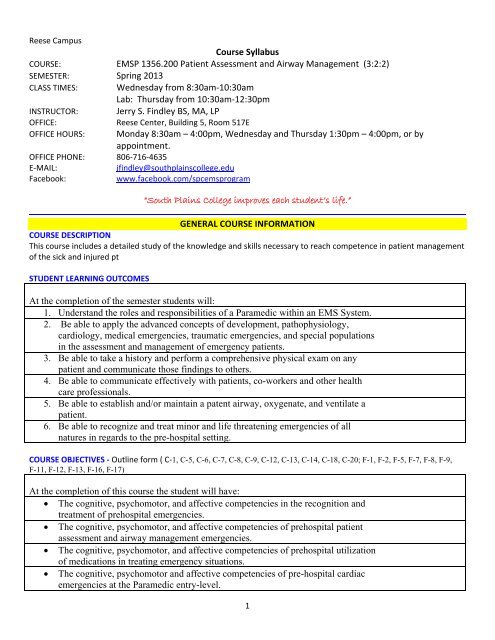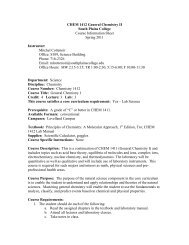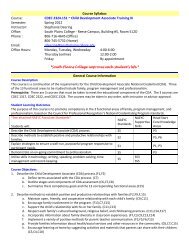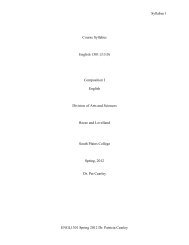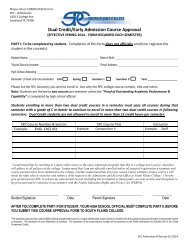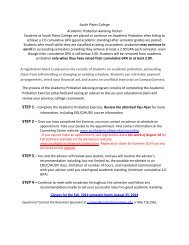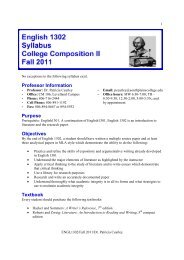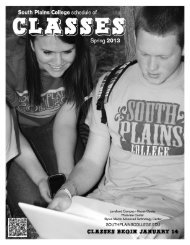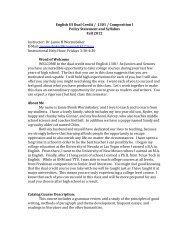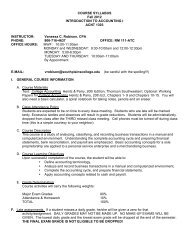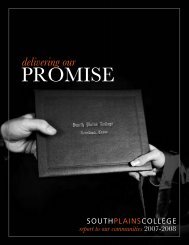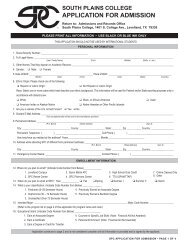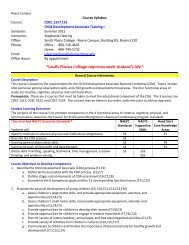Course Syllabus EMSP 1356.200 Patient Assessment and Airway ...
Course Syllabus EMSP 1356.200 Patient Assessment and Airway ...
Course Syllabus EMSP 1356.200 Patient Assessment and Airway ...
- No tags were found...
You also want an ePaper? Increase the reach of your titles
YUMPU automatically turns print PDFs into web optimized ePapers that Google loves.
EVALUATION METHODSComputer‐based exams, written exams, written assignments, quizzes, <strong>and</strong> other projects as assigned.ACADEMIC INTEGRITYIt is the aim of the faculty of South Plains College to foster a spirit of complete honesty <strong>and</strong> a high st<strong>and</strong>ard of integrity.The attempt of any student to present as his or her own any work which he or she has not honestly performed isregarded by the faculty <strong>and</strong> administration as a most serious offense <strong>and</strong> renders the offender liable to seriousconsequences, possibly suspension.Cheating ‐ Dishonesty of any kind on examinations or on written assignments, illegal possession of examinations, theuse of unauthorized notes during an examination, obtaining information during an examination from the textbook orfrom the examination paper of another student, assisting others to cheat, alteration of grade records, illegal entry orunauthorized presence in the office are examples of cheating. Complete honesty is required of the student in thepresentation of any <strong>and</strong> all phases of coursework. This applies to quizzes of whatever length, as well as finalexaminations, to daily reports <strong>and</strong> to term papers.Plagiarism ‐ Offering the work of another as one's own, without proper acknowledgment, is plagiarism; therefore, anystudent who fails to give credit for quotations or essentially identical expression of material taken from books,encyclopedias, magazines <strong>and</strong> other reference works, or from themes, reports or other writings of a fellow student, isguilty of plagiarism.VARIFICATION OF WORKPLACE COMPETENCIESParamedics are expected to know how to read a cardiac monitor <strong>and</strong> provide treatment based on their training.SCANS <strong>and</strong> FOUNDATION SKILLSRefer also to <strong>Course</strong> Objectives. Scans <strong>and</strong> Foundation Skills attachedSPECIFIC COURSE INFORMATIONTEXT AND MATERIALSTEXTBOOK Publisher ISBN#Essentials of Paramedic Care, 2 nd Ed., (Update) Brady ISBN#: 978-0-13-215689-9Essentials of Paramedic Care – Workbook (Update) Brady ISBN#: 978-0-13-138442-22
Nursing 2012 Drug H<strong>and</strong>book Wolters Kluwer ISBN#: 978-1-60913-619-2Additional Items That Must Be Purchased Each Semester:SPC EMS Program Policy& Clinical H<strong>and</strong>book SPC Program Copy SPC BookstoreFISDAP Clinical Rotation Tracking Software Access Code (*one time purchase) SPC BookstoreSUGGESTED TEXTSEMS Pocket Field Guide, ALS Version InforMed Co. ISBN#: 9781890495329ADDITIONAL CLASSROOM ITEMSStudents should come to class prepared with pens, pencils, <strong>and</strong> a spiral notebook for taking notes or completed quizzesor assignments in class. Students should be prepared to take notes over lecture material if they choose.ATTENDANCE POLICY (*READ CAREFULLY)“Punctual <strong>and</strong> regular class attendance is required of all students attending South Plains College. There are noexcused absences. Students are responsible for all class work covered during absences from class, even in casesin which they are able to satisfy the instructor that the absence was unavoidable.” (South Plains CollegeStudent Guide, 2011-2012, pp.20)“Whenever absences become excessive <strong>and</strong>, in the instructor’s opinion, minimum course objectives cannot bemet due to absences, the student should be withdrawn from the course.” (South Plains College GeneralCatalog, 2011-2012, pp.20)Due to the importance of the emergency medical information being taught, the instructor of this coursedefines excessive absences as missing the 3rd class day (or having equivalent tardies) in a course section.A student who meets this criteria will be administratively dropped from the course by the instructor.• Tardies: (Definintion): arriving any time after the class has started or not returning from an approvedbreak after class has started.• Two tardies will be considered missing one class day <strong>and</strong> counted as such.• Work schedule is not an excuse for missing class.• Any exceptions to this policy must be discussed on an individual basis with the course instructor <strong>and</strong> theEMS Program Director. (i.e. – student hospitalization, immediate family member death, etc.)ASSIGNMENT POLICYAll assignments must be completed by the assigned due date. Late <strong>and</strong>/or incomplete work will not beaccepted <strong>and</strong> a grade of zero will be recorded. Assignments, quizzes, exams, <strong>and</strong> skills that are missed due toan unexcused absence may not be made up. See the instructor for more specific information.COMPUTER USAGE3
Grading Scale: 90‐100 A80‐89 B75‐79 C70‐74 D69 or Below FCOURSE COMPLETION CERTIFICATEPlease refer to the most current version of the SPC EMS Program H<strong>and</strong>book for eligibility details.CASE REVIEW PROJECTIn order to stay current with local EMS practices, students will be required to attend one regional case review <strong>and</strong> reporton their findings. The grading rubric <strong>and</strong> further detail will be provided to the students at the start of this course.COMMUNICATION POLICY• Electronic communication between instructor <strong>and</strong> students in this course will utilize the South Plains College “MySPC” <strong>and</strong> email systems. The instructor will not initiate communication using private email accounts. Students areencouraged to check SPC email on a regular basis each week of class. Students will also have access to assignments,web‐links, h<strong>and</strong>outs, <strong>and</strong> other vital material which will be delivered via the classroom website. Any student havingdifficulty accessing the classroom website or their email should immediately contact their instructor for direction.The instructor will work with any student to ensure the student has access to a computer on campus <strong>and</strong> can obtainthe needed class content that is located on the course website.STUDENT CONDUCT• Students in this class are expected to abide by the st<strong>and</strong>ards of student conduct as defined in the SPC Student Guidepages 10‐15.SPECIAL REQUIREMENTS (*Read Carefully)• Students must present a signed original hardcopy of each of the following: syllabus signature page, SPCEMS Program H<strong>and</strong>book signature page, SPC EMS Clinical H<strong>and</strong>book signature page, & Student Guidesignature page. These signature pages are due by Thursday of the first week of classes.• Cell Phones – Cell phones are to be turned OFF or silenced during scheduled class periods. Textmessaging is not allowed during scheduled class/lab times. Cell phones are to be used outside theclassroom or lab only on designated breaks. Students are not allowed to have cell phones on theirperson during exams.• Class Dress Code – Due to the environment of the scheduled lab dates, students are required to wearthe following:a. Jeansb. Closed toed shoes or bootsc. Collared shirt or T‐shirtd. Watch with a second h<strong>and</strong>e. Stethoscope (optional)WHAT NOT TO WEAR: hats, flip‐flops, shorts, torn jeans, low cut blouses, private EMS uniforms.• These guidelines are for your protection due to the nature of the EMS environment <strong>and</strong> the amountof lifting <strong>and</strong> moving that will take place in the lab.5
• If you are employed by a local or regional EMS service, do not wear your uniform, badge, pager, orradio to class as this causes distractions from the teaching environment.COURSE DISCLAIMERWorking with the public in emergency situations is stressful <strong>and</strong> requires a mentally tough individual toprovide medical care in the prehospital environment. This course is designed to teach students about realworldsituations the EMT – Paramedic may potentially encounter in the ‘field’ while managing patient care.In order to better prepare students for a career in the Emergency Medical Services profession, there will betimes during this course where students will be exposed to training scenarios <strong>and</strong> situations that will beunpleasant to the average college student. If the student does not feel they can tolerate this type oflearning environment, they should discuss this with me immediately before continuing the course.Jerry S. Findley, BS, MA, LP6
COURSE OUTLINESouth Plains CollegeAllied Health Division EMS ProgramsAdvanced Classroom Schedule Spring 2013Class Date Day Content Area ChaptersClass 1 1.16.13 Wednesday Trauma Systems<strong>Airway</strong>168Class 2 1.17.13 Thursday LabClass 3 1.23.13 Wednesday Blunt Trauma<strong>Airway</strong>178Class 4 1.24.13 Thursday LabClass 5 1.30.13 Wednesday Penetrating TraumaIV187Class 6 1.31.13 Thursday LabClass 7 2.6.13 Wednesday Hemorrhage <strong>and</strong> ShockAbdominal <strong>and</strong>1926 <strong>and</strong> 28CardiologyClass 8 2.7.13 Thursday LabClass 9 2.13.13 Wednesday Exam 1Class 10 2.14.13 Thursday LabClass 11 2.20.13 Wednesday Soft Tissue TraumaNeurology2029Class 12 2.21.13 Thursday LabClass 13 2.27.13 Wednesday BurnsBehavioral2138Class 14 2.28.13 Thursday LabClass 15 3.6.13 Wednesday MusculoskeletalTraumaEndocrinology, Allergies2230 <strong>and</strong> 31<strong>and</strong> AnaphylaxisClass 16 3.7.13 Thursday LabClass 17 3.20.13 Wednesday Exam 2Class 18 3.21.13 Thursday LabClass 19 3.27.13 Wednesday Head <strong>and</strong> Face TraumaGI <strong>and</strong> Urology2332 <strong>and</strong> 33Class 20 3.28.13 Thursday LabClass 21 4.3.13 Wednesday Spinal TraumaToxicology <strong>and</strong>Hematology72434 <strong>and</strong> 35Class 22 4.4.13 Thursday LabClass 23 4.10.13 Wednesday Environmental <strong>and</strong> 36 <strong>and</strong> 37Infectious Disease
Class 24 4.11.13 Thursday LabClass 25 4.17.13 Wednesday Thoracic Trauma25OB/GYN39 <strong>and</strong> 40Class 26 4.18.13 Thursday LabClass 27 4.24.13 Wednesday Trauma MathH<strong>and</strong>outsPediatrics42Class 28 4.25.13 Thursday LabClass 29 5.1.13 Wednesday GCS <strong>and</strong> RTSH<strong>and</strong>outsAbuse/Crime Scene 44 <strong>and</strong> 48 Total ContactHours: 64 Class 30 5.2.13 Thursday LabClass 31 5.7.13 Tuesday Comprehensive FinalTotal Clinical<strong>and</strong> Field Hours: 300Hours minimumSee Clinical <strong>Course</strong> syllabi <strong>and</strong> h<strong>and</strong>book for clinical specificsImportant Dates:January 21 stMarch 11-15April 1 stApril 23 rdMLK HolidaySpring BreakEaster Holiday*Last day to drop a course8
ACCOMMODATIONSDIVERSITY STATEMENTIn this class, the instructor will establish <strong>and</strong> support an environment that values <strong>and</strong> nurtures individual <strong>and</strong> groupdifferences <strong>and</strong> encourages engagement <strong>and</strong> interaction. Underst<strong>and</strong>ing <strong>and</strong> respecting multiple experiences <strong>and</strong>perspectives will serve to challenge <strong>and</strong> stimulate all of us to learn about others, about the larger world <strong>and</strong> aboutourselves. By promoting diversity <strong>and</strong> intellectual exchange, we will not only mirror society as it is, but also modelsociety as it should <strong>and</strong> can be.DISABILITIES STATEMENTStudents with disabilities, including but not limited to physical, psychiatric, or learning disabilities, who wish to requestaccommodations in this class should notify the Special Services Office early in the semester so that the appropriatearrangements may be made. In accordance with federal law, a student requesting accommodations must provideacceptable documentation of his/her disability to the Coordinator of Special Services. For more information, call orvisit the Special Services Office in rooms 809 <strong>and</strong> 811, Reese Center Building 8, (806) 885‐3048 ext. 4654.FOUNDATION SKILLSBASIC SKILLS–Reads, Writes, Performs Arithmetic <strong>and</strong> Mathematical Operations, Listens <strong>and</strong> SpeaksF‐1 Reading–locates, underst<strong>and</strong>s, <strong>and</strong> interprets written information in prose <strong>and</strong> in documents such asmanuals, graphs, <strong>and</strong> schedules.F‐2 Writing–communicates thoughts, ideas, information <strong>and</strong> messages in writing <strong>and</strong> creates documents suchas letters, directions, manuals, reports, graphs, <strong>and</strong> flow charts.F‐3 Arithmetic–performs basic computations; uses basic numerical concepts such as whole numbers, etc.F‐4 Mathematics–approaches practical problems by choosing appropriately from a variety of mathematicaltechniques.F‐5 Listening–receives, attends to, interprets, <strong>and</strong> responds to verbal messages <strong>and</strong> other cues.F‐6 Speaking–organizes ideas <strong>and</strong> communicates orally.THINKING SKILLS–Thinks Creatively, Makes Decisions, Solves Problems, Visualizes <strong>and</strong> Knows How to Learn<strong>and</strong> ReasonF‐7 Creative Thinking–generates new ideas.F‐8 Decision‐Making–specifies goals <strong>and</strong> constraints, generates alternatives, considers risks, evaluates <strong>and</strong>chooses best alternative.F‐9 Problem Solving–recognizes problems, devises <strong>and</strong> implements plan of action.F‐10 Seeing Things in the Mind’s Eye–organizes <strong>and</strong> processes symbols, pictures, graphs, objects, <strong>and</strong> otherinformation.F‐11 Knowing How to Learn–uses efficient learning techniques to acquire <strong>and</strong> apply new knowledge <strong>and</strong> skills.F‐12 Reasoning–discovers a rule or principle underlying the relationship between two or more objects <strong>and</strong>applies it when solving a problem.PERSONAL QUALITIES–Displays Responsibility, Self‐Esteem, Sociability, Self‐Management, Integrity <strong>and</strong>HonestyF‐13 Responsibility–exerts a high level of effort <strong>and</strong> perseveres towards goal attainment.F‐14 Self‐Esteem–believes in own self‐worth <strong>and</strong> maintains a positive view of self.F‐15 Sociability–demonstrates underst<strong>and</strong>ing, friendliness, adaptability, empathy <strong>and</strong> politeness in groupsettings.9
F‐16 Self‐Management–assesses self accurately, sets personal goals, monitors progress <strong>and</strong> exhibits selfcontrol.F‐17 Integrity/Honesty–chooses ethical courses of action.SCANS COMPETENCIESC‐1 TIME ‐ Selects goal ‐ relevant activities, ranks them, allocates time, prepares <strong>and</strong> follows schedules.C‐2 MONEY ‐ Uses or prepares budgets, makes forecasts, keeps records <strong>and</strong> makes adjustments to meetobjectives.C‐3 MATERIALS AND FACILITIES ‐ Acquires, stores, allocates, <strong>and</strong> uses materials or space efficiently.C‐4 HUMAN RESOURCES ‐ Assesses skills <strong>and</strong> distributes work accordingly, evaluates performances <strong>and</strong>provides feedback.INFORMATION ‐ Acquires <strong>and</strong> Uses InformationC‐5 Acquires <strong>and</strong> evaluates information.C‐6 Organizes <strong>and</strong> maintains information.C‐7 Interprets <strong>and</strong> communicates information.C‐8 Uses computers to process information.INTERPERSONAL–Works With OthersC‐9 Participates as a member of a team <strong>and</strong> contributes to group effort.C‐10 Teaches others new skills.C‐11 Serves Clients/Customers–works to satisfy customer’s expectations.C‐12 Exercises Leadership–communicates ideas to justify position, persuades <strong>and</strong> convinces others,responsibly challenges existing procedures <strong>and</strong> policies.C‐13 Negotiates‐works toward agreements involving exchanges of resources; resolves divergent interests.C‐14 Works With Diversity–works well with men <strong>and</strong> women from diverse backgrounds.SYSTEMS–Underst<strong>and</strong>s Complex InterrelationshipsC‐15 Underst<strong>and</strong>s Systems–knows how social, organizational, <strong>and</strong> technological systems work <strong>and</strong> operateseffectively with them.C‐16 Monitors <strong>and</strong> Corrects Performance–distinguishes trends, predicts impacts on system operations,diagnoses systems performance <strong>and</strong> corrects malfunctions.C‐17 Improves or Designs Systems–suggests modifications to existing systems <strong>and</strong> develops new or alternativesystems to improve performance.TECHNOLOGY–Works with a Variety of TechnologiesC‐18 Selects Technology–chooses procedures, tools, or equipment, including computers <strong>and</strong> relatedtechnologies.C‐19 Applies Technology to Task–underst<strong>and</strong>s overall intent <strong>and</strong> proper procedures for setup <strong>and</strong> operation ofequipment.C‐20 Maintains <strong>and</strong> Troubleshoots Equipment–prevents, identifies, or solves problems with equipment,including computers <strong>and</strong> other technologies.10
I (print name) _______________________________________have received <strong>and</strong> read a copy of thesyllabus for the EMS Advanced Program (<strong>EMSP</strong> <strong>1356.200</strong> – <strong>Patient</strong> <strong>Assessment</strong> <strong>and</strong> <strong>Airway</strong>Management). I underst<strong>and</strong> the syllabus <strong>and</strong> underst<strong>and</strong> that I must comply with all requirementslisted within this document to complete the course.________________________________________Signature of Student________________________________________Date11


